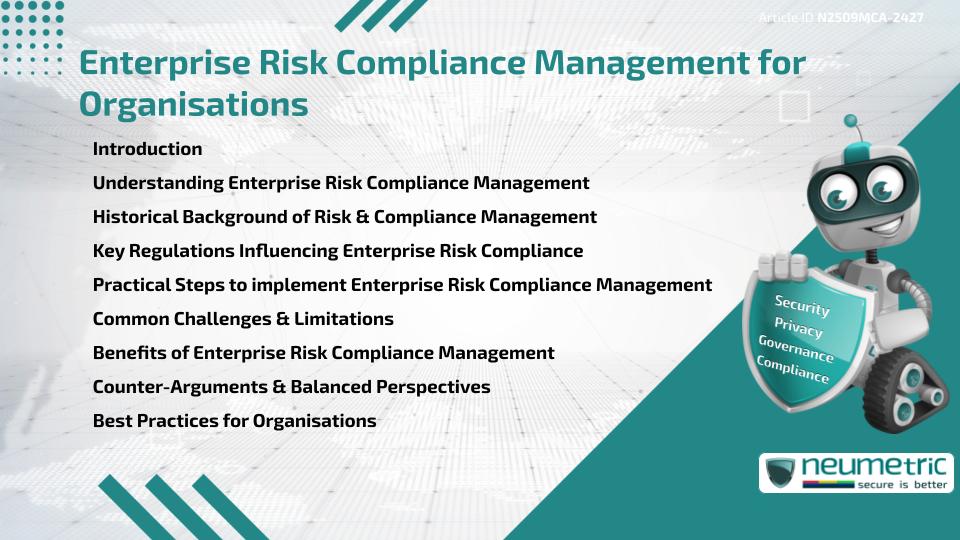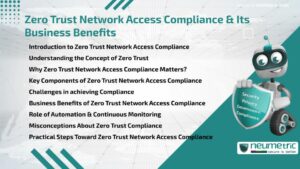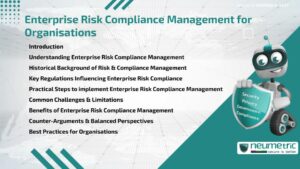Table of Contents
ToggleIntroduction
Enterprise Risk Compliance Management is an essential process for organisations aiming to identify Risks, meet Regulatory obligations & strengthen Governance. It provides a structured approach to aligning Risk Management with Compliance Requirements while safeguarding reputation & Business Continuity. By implementing Enterprise Risk Compliance Management, organisations can improve decision-making, reduce exposure to legal penalties & build Stakeholder Trust. This article explores its meaning, history, regulations, benefits, challenges & Best Practices.
Understanding Enterprise Risk Compliance Management
Enterprise Risk Compliance Management combines Risk identification, monitoring & Compliance oversight within a single Framework. It ensures organisations proactively address Risks while adhering to relevant laws & standards. Just as traffic rules keep drivers Safe & Accountable, this Framework helps Enterprises operate responsibly while avoiding Legal & Financial repercussions.
Historical Background of Risk & Compliance Management
The foundations of Risk & Compliance management can be traced to Financial regulations introduced after global economic crises in the early 20th century. In the 1990s & 2000s, corporate scandals & data breaches prompted stronger Compliance frameworks across industries. Today, Enterprise Risk Compliance Management has expanded to cover Cybersecurity, Privacy, Financial Integrity & Environmental Sustainability, reflecting the interconnected Risks modern organisations face.
Key Regulations Influencing Enterprise Risk Compliance
Several Global Standards & regulations guide Enterprise Risk Compliance Management:
- Sarbanes-Oxley Act [SOX]: Establishes corporate Governance & Financial reporting standards.
- General Data Protection Regulation [GDPR]: Enforces strict Data Protection & accountability measures.
- Health Insurance Portability & Accountability Act [HIPAA]: Regulates Privacy & security of Healthcare information.
- ISO 31000: Provides global principles for Risk Management frameworks.
- NIST Risk Management Framework: Offers structured guidelines for managing security & Compliance Risks.
Practical Steps to implement Enterprise Risk Compliance Management
Organisations can establish effective Enterprise Risk Compliance Management by:
- Conducting Risk Assessments to identify Vulnerabilities.
- Mapping applicable Regulatory requirements to business functions.
- Developing Policies for Risk monitoring & Compliance reporting.
- Using technology tools for centralised Governance & oversight.
- Training Employees on Compliance responsibilities.
- Conducting regular Internal Audits & Assessments.
Common Challenges & Limitations
Implementing Enterprise Risk Compliance Management can be complex & resource-intensive. Organisations may struggle with overlapping Regulatory requirements across jurisdictions, high costs of Compliance tools & insufficient expertise. Additionally, focusing too heavily on Compliance can sometimes divert attention from broader Risk Mitigation strategies.
Benefits of Enterprise Risk Compliance Management
An integrated approach to Enterprise Risk & Compliance offers numerous advantages:
- Reduces exposure to Financial & Legal penalties.
- Improves Governance & Accountability structures.
- Enhances operational resilience by addressing Risks early.
- Builds stronger Trust with Stakeholders, Regulators & Customers.
- Provides actionable insights through Continuous Monitoring & Reporting.
Counter-Arguments & Balanced Perspectives
Some critics argue that Enterprise Risk Compliance Management can lead to bureaucracy, slowing decision-making & Innovation. Others point out that excessive focus on Compliance may create a “Checklist Culture” where organisations prioritise documentation over meaningful action. A balanced approach requires combining Compliance with practical Risk Management strategies that support long-term Business Objectives.
Best Practices for Organisations
- Align Enterprise Risk Compliance Management with organisational strategy.
- Automate Compliance monitoring & reporting to improve efficiency.
- Review frameworks regularly to adapt to evolving Risks & Regulations.
- Foster a culture of Accountability through training & awareness.
- Involve leadership in Risk & Compliance decisions to strengthen oversight.
Conclusion
Enterprise Risk Compliance Management is a cornerstone of responsible organisational Governance. By integrating Risk Management with Regulatory Compliance, Enterprises can protect themselves against legal, financial & reputational Threats while fostering operational resilience. Understanding its history, challenges & benefits allows organisations to approach Compliance not as a burden, but as a driver of sustainable success.
Takeaways
- Enterprise Risk Compliance Management aligns Risk Management with Compliance obligations.
- SOX, GDPR, HIPAA, ISO 31000 & NIST frameworks shape Compliance practices.
- Implementation involves Risk Assessments, Governance Policies & Employee Training.
- Challenges include overlapping regulations, costs & potential bureaucracy.
- A balanced strategy integrates Compliance with practical Risk Mitigation.
FAQ
What is Enterprise Risk Compliance Management?
It is a structured Framework that integrates Risk Management with Compliance to ensure organisations meet legal & operational obligations.
Why is Enterprise Risk Compliance Management important?
It reduces legal & Financial Risks, improves Governance & strengthens Stakeholder confidence.
Which regulations influence Enterprise Risk Compliance Management?
Key frameworks include SOX, GDPR, HIPAA, ISO 31000 & the NIST Risk Management Framework.
What are common challenges in Enterprise Risk Compliance Management?
Challenges include high costs, complex overlapping regulations & Risk of excessive bureaucracy.
How can organisations implement Enterprise Risk Compliance Management?
By conducting Risk Assessments, mapping regulations, automating monitoring & training Employees.
Does Enterprise Risk Compliance Management benefit small organisations?
Yes, but small organisations may adopt scaled or simplified frameworks to match their resources.
Is Compliance alone enough to manage Risks?
No, Compliance is only part of the equation-organisations must integrate practical Risk Mitigation strategies as well.
Need help for Security, Privacy, Governance & VAPT?
Neumetric provides organisations the necessary help to achieve their Cybersecurity, Compliance, Governance, Privacy, Certifications & Pentesting needs.
Organisations & Businesses, specifically those which provide SaaS & AI Solutions in the Fintech, BFSI & other regulated sectors, usually need a Cybersecurity Partner for meeting & maintaining the ongoing Security & Privacy needs & requirements of their Enterprise Clients & Privacy conscious Customers.
SOC 2, ISO 27001, ISO 42001, NIST, HIPAA, HECVAT, EU GDPR are some of the Frameworks that are served by Fusion – a SaaS, multimodular, multitenant, centralised, automated, Cybersecurity & Compliance Management system.
Neumetric also provides Expert Services for technical security which covers VAPT for Web Applications, APIs, iOS & Android Mobile Apps, Security Testing for AWS & other Cloud Environments & Cloud Infrastructure & other similar scopes.
Reach out to us by Email or filling out the Contact Form…





